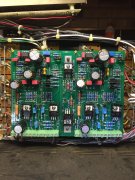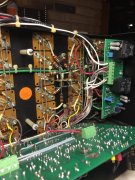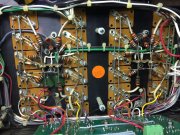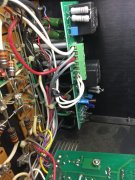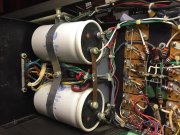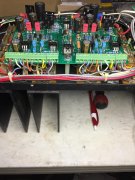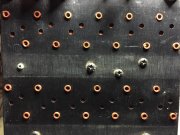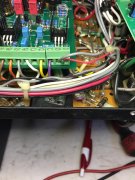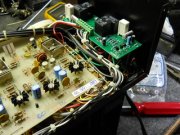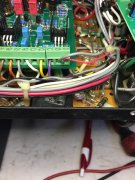I have a PL700 Series Two, that I bought from a gear buddy of mine, that is having output issues. Back story goes like this; He bought two original 700IIs loooong ago and played them for years until he sold them to a gear buddy of his that bought them, played them for a while until he didn't. They sat in his house for years. So my buddy buys them back with intentions of upgrading them with WOA control boards and wattsabundant DC protect circuits. He found a tech that would do this for him so he hands over his two 700IIs to be upgraded. Tech guy proceeds to do his thing to the amps. When the first one is done he records a video of it playing and sends it to buddy. Buddy says keep it until both of them are ready. Well, that day never came, as the second amp never came back to life. So, he picks them up as is, thinking he has at least one working amp out of the two. Gets them home, the first one(from the video) now has bad distortion and very low output, with the right channel outputs getting very hot to the touch. Tech guy never says a word about that, and at this point there is no communication between the two of them any longer, so there isn't any way for me to ask him what all he did to either amp. Not that I feel like he would tell me straight.
So ff to a couple weeks ago; I buy the first(video) amp from him with intentions of troubleshooting the control board to see if I can get it going. It has the WOA Rev. E control board in it that the Tech guy built. From this point I'll refer to him as Tech guy, I don't know him. It has a wattsabundant DC protect board in it. All new ON MJ15024G(BM1811) outputs, and 4 RCA 66546 drivers with silpads mounted to stock back planes. New RCA inputs, and new outputs. Various new wiring throughout the amp. The PS filter caps look original. All fuses are correct and good. One 10A main, and 4 AGX5 . This amp looks immaculate inside and out, save for a little dust from sitting out of his cabinet all year long.
On a suggestion from a well known WOPL builder friend of mine, I was told to remove the outputs from that channel and power it up on a DBT to check voltages. I did that, and no shorts on DBT powered up with my variac. Relay clicks in as normal. So I decide to hook a pre amp to it and a speaker to the left channel to see if it is distorted. It played clear, but after about 30 seconds I see magic smoke appear from the back plane on the right channel, so I switch it off.
I've been able to switch it on for a few seconds at a time to check some voltages to compare left and right channels on the control board. After about 10-15 seconds I can smell something getting hot so I switch it back off. I am getting different voltages from some of the points on the lugs at the bottom of the board, and also at the two op-amps at the top of the control board. Just checking the outputs in the diode mode on my DMM, all of them are checking good on the meter, but I haven't checked any of them in circuit.
I can get some more voltage readings and whatever else I need to do to check the control board for proper operation with recommendations from the group if anyone wants to help diagnose this problem. I know it's hard to do long distance. Thanks for any help or suggestions.
So ff to a couple weeks ago; I buy the first(video) amp from him with intentions of troubleshooting the control board to see if I can get it going. It has the WOA Rev. E control board in it that the Tech guy built. From this point I'll refer to him as Tech guy, I don't know him. It has a wattsabundant DC protect board in it. All new ON MJ15024G(BM1811) outputs, and 4 RCA 66546 drivers with silpads mounted to stock back planes. New RCA inputs, and new outputs. Various new wiring throughout the amp. The PS filter caps look original. All fuses are correct and good. One 10A main, and 4 AGX5 . This amp looks immaculate inside and out, save for a little dust from sitting out of his cabinet all year long.
On a suggestion from a well known WOPL builder friend of mine, I was told to remove the outputs from that channel and power it up on a DBT to check voltages. I did that, and no shorts on DBT powered up with my variac. Relay clicks in as normal. So I decide to hook a pre amp to it and a speaker to the left channel to see if it is distorted. It played clear, but after about 30 seconds I see magic smoke appear from the back plane on the right channel, so I switch it off.
I've been able to switch it on for a few seconds at a time to check some voltages to compare left and right channels on the control board. After about 10-15 seconds I can smell something getting hot so I switch it back off. I am getting different voltages from some of the points on the lugs at the bottom of the board, and also at the two op-amps at the top of the control board. Just checking the outputs in the diode mode on my DMM, all of them are checking good on the meter, but I haven't checked any of them in circuit.
I can get some more voltage readings and whatever else I need to do to check the control board for proper operation with recommendations from the group if anyone wants to help diagnose this problem. I know it's hard to do long distance. Thanks for any help or suggestions.
Attachments
-
189 KB Views: 36
-
159.4 KB Views: 36
-
195.9 KB Views: 40
-
146.7 KB Views: 39
-
145.5 KB Views: 40
-
138.7 KB Views: 38
-
144.3 KB Views: 35

